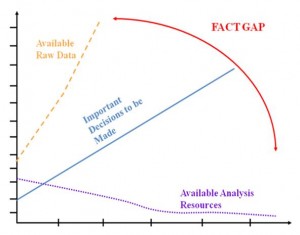The Data Fact Gap
August 6, 2014 by Julia·
Leave a Comment
As professionals, we all know that technology has changed the way we do business. Whether you find the increased dependence on new technology as good or bad often depends on how effectively the tools are used. Over the years, this problem has been illustrated in many ways by Stics and a variety of other experts.
This particular Fact Gap illustration was first attributed to the Gartner Group. It will help us describe how data technologies are, on the one hand, progressing and on the other, creating new data analysis problems.
The “Data Fact Gap” was created by the explosion of available digital information accumulated in recent years. With technology system advances, increased data storage capacity and Internet usage it is now easy to collect mountains of data. While the volume of retained data has grown exponentially and spread across all industries, so have the data management challenges it created and the even greater marketing opportunities that mostly lie dormant.
This abundance of data creates new problems that force database marketers to devote a lot of time and resources to filtering information into data segments so decision makers can frame a concept, problem or question. While this approach is intuitive to the human brain, it does limit our ability to make a fully informed decision from all available data.
Why You Need Good Data
Intuitively we often think we already know what our customers want. However, that is not always the case. When we make business decisions by filtering our data down to a few variables we miss the more accurate and complete view of the data. Without hard data, there’s no way to be sure truly objective decisions are being made. Worse, because we think we’re making objective decisions, we often don’t seek an outside perspective.
What we really need is an objective analysis, wielding as many customer factors and data points as possible. This approach helps us see the potential hidden below the common database marketing analysis.
Statistical Predictive Analytics Solves the Problem
One way to harness the data explosion and make better marketing and business decisions is to use predictive analytics. Predictive analytics uses the science of statistics and is capable of considering unlimited facets of a situation. Predictive analytics for marketing can increase a marketing campaign’s return on investment by 10 times compared to a typical SQL analysis that might only evaluate (about) five variables. It takes the data that you already have and gives you information you can use in your marketing campaigns, such as:
- Identifying customers you are currently marketing to who are unprofitable or about to reach the end of their customer lifetime value
- Identify high value customers hiding in your database or prospects you are not marketing to
- Suggest more profitable marketing programs
- Identify the lifetime value of various members in your customer base
Statistical modeling with predictive analytics is proven to help make more informed decisions and increase profit margins.
Stics lives on the front lines of customer data knowledge generation. We have a deep understanding of the problems and opportunities created by the data explosion. For that reason, we discourage installing expensive applications that might not provide quick answers to important questions that drive revenue and profitability. We know that with seasoned expertise, a leading statistical technology platform and focused services like ours, it is possible to bridge the data gap and quickly and easily improve the performance of your marketing campaigns.
Stics offers innovative solutions that provide deeper insight into your customer and loyalty database for greater marketing return on investment. We welcome inquiries and are happy to answer questions. We’re waiting to talk to you. Let us know what’s on your mind.











